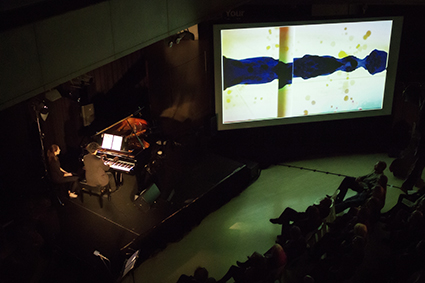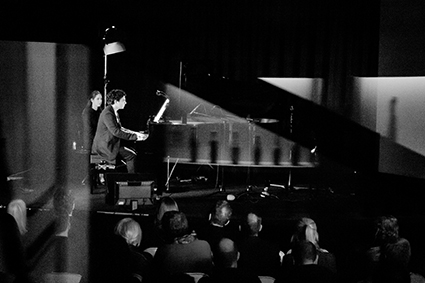 |
Zubin Kanga photo Holly Jade |
The concert opens with Piano Hero by Stefan Prins, in which Kanga operates a MIDI keyboard that in turn triggers video samples of a pianist, shown via projection. The virtual pianist manipulates the inside of a grand piano with a variety of tools and broken keys. The video skips around, playing with speed and reversed time, messing with our perception of pace through the work. Though the video is absorbing to watch, the true strength of the piece is not in what we hear or see necessarily, but in the fact that we understand how it has been made and that we can see this process unfolding before us. Kanga’s program note suggests that the piece is a comment on the trend of the virtual replacing the real and indeed the chain of command from MIDI keyboard to projection suggested a kind of redundancy.
Julian Day’s labyrinthine Dark Twin pitted Kanga against a prerecorded version of himself playing rhythmically relentless clusters. At first the live performance is indistinguishable from the electronic, but as a disparity is slowly revealed the sound begins to sparkle hauntingly and a range of ethereal colours are introduced. The depth of the sound seems to continuously expand as the tone colour of the electronics obscures the rhythmic clarity and takes the piece to quite a dark place. The electronics perfectly complement the live sound, clouding but not obscuring Kanga’s energetic performance.
Live electronics were further explored in Benjamin Carey’s _derivations, a program developed as part of his PhD at UTS. The goal of _derivations is to follow the improvisations of a solo performer and learn from the sound—at first mimicking, but growing eventually into an intelligent duetting partner. The piece unfolds with beautiful harmonic tensions, with Carey’s electronics expanding the depth and density of the sound world quite tastefully. It was a little hard to get a sense of the ‘intelligence’ of the _derivations program, as it seemed to merely repeat Kanga’s phrases back and add reverberation. It would have been interesting to hear the piece go on for much longer, or to hear _derivations respond to a much more minimal improvisation, so as to highlight the interaction between parts. One also wonders about the ownership of this piece—so much of the artistry of the sound and success of the piece came from Kanga’s mindful improvisation.
 |
Zubin Kanga photo Holly Jade |
In Daniel Blinkhorn’s FrostbYte: Chalk Outline, footage and field recordings of the Arctic Archipelago of Svalbard are met with a tinkling piano sound and icy electronic effects. The work captured a sense of open space with resonant gestures interacting with periods of silence. Fairly late in the piece a rhythmic impetus was established, with dubstepian thumps and clicks as the footage took an industrial turn. The video footage was partially obfuscated by special effects and filters that felt a little unnecessary. Nonetheless this was quite a successful work, capturing what felt like a very personal impression of the glacial Arctic landscape.
Cat Hope’s new work, The Fourth Estate, focused on interference, using radios and EBows as “sonic barriers” to Kanga’s fluid piano part. My impression of the piece was perhaps the opposite of what Hope intended—in fact the work inside the piano and the hushed radio noise blended very well with Kanga’s playing and created quite pleasant listening. Indeed, it was these extra colours provided by the interference that gave the work its energy. The program note states that this work “explores the damaging influence that the media can have on all aspects of society”. I obviously cannot speak on Hope’s behalf, but to me this feels like a contrived interpretation of the concept of interference, perhaps designed to give the audience something to hold onto as they listen but probably not an informative part of the compositional process.
Kanga concluded his program with a visceral performance of a new arrangement of Steve Reich’s Six Pianos (1973) by Vincent Corver for only one piano and four pre-recorded tracks. Kanga clearly enjoys himself as he performs with clarity and precision, bringing out the lines of most interest. Along with many other audience members I found myself having to stop myself from tapping my foot and nodding my head in time to the incredibly rhythmic music. However I do wonder what was gained by performing such a piece with only one piano instead of six, except of course practicality—it is certainly less visually stimulating. Perhaps it allowed us an insight into the interaction of one specific part against the wash of sound, to guide us through the piece—and Kanga’s part certainly did have all the most interesting gestures. It was certainly a fitting end to the technology-infused program.
Zubin Kanga, Dark Twin, Totally Huge New Music Festival, Art Gallery of Western Australia, Perth
© Alex Turley; for permission to reproduce apply to [email protected]








 back
back